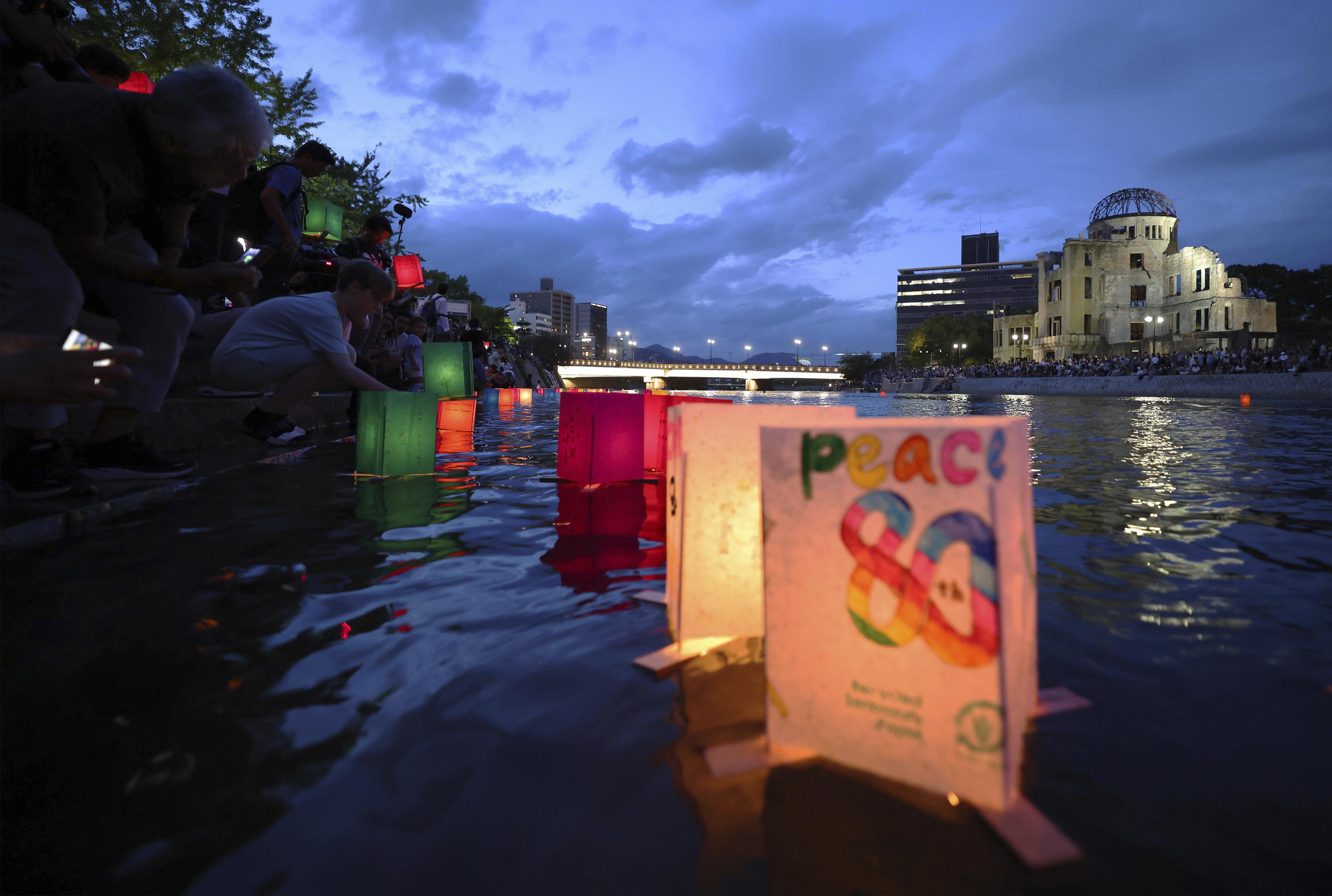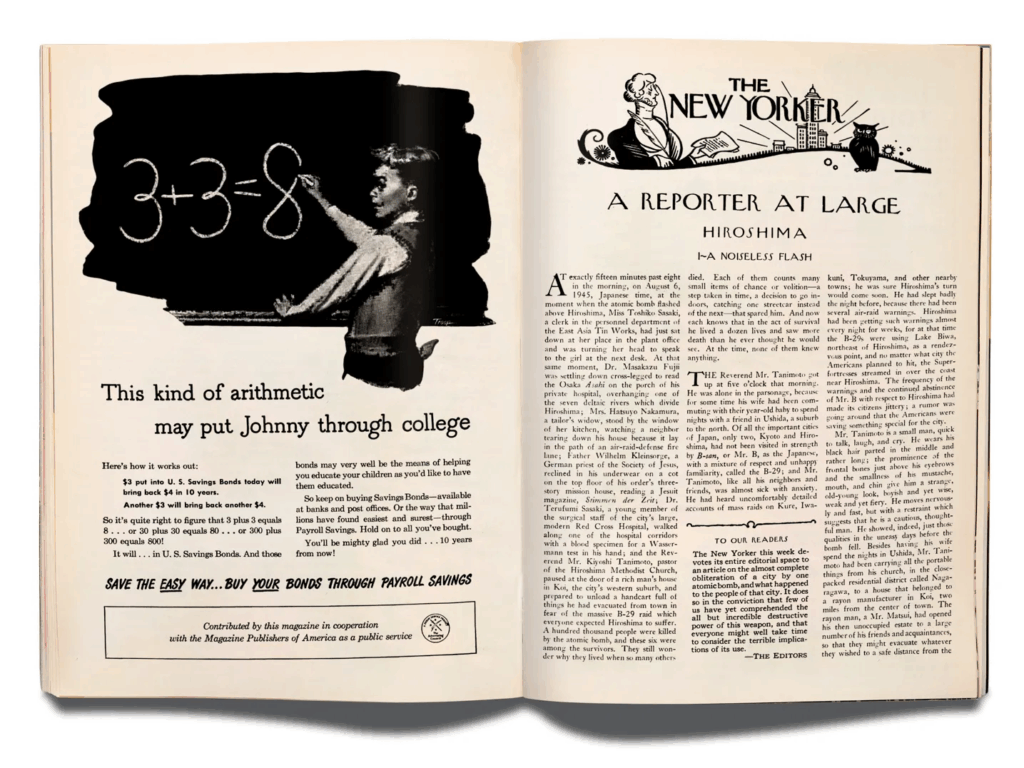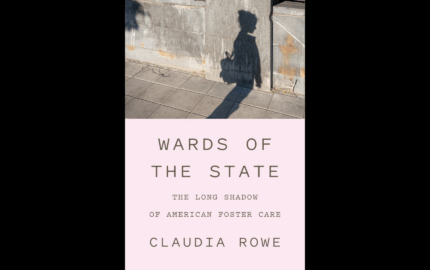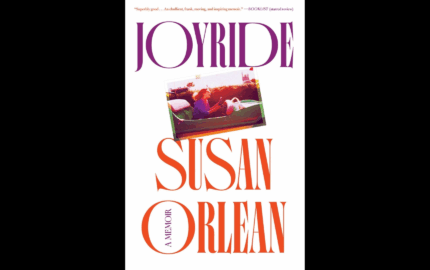Sign up for the Nieman Storyboard newsletter, delivered every Friday in your inbox.
***
Dear Storyboard community,
This week marks 80 years since the U.S. atomic bombings of Hiroshima and Nagasaki, which destroyed both cities and killed some 210,000 people, including tens of thousands of children.
It provides a moment to reflect on the horrors of war, and to reread John Hersey's "Hiroshima," published in The New Yorker one year later, in August 1946. The article shaped the world’s collective memory of the event. It begins:
At exactly fifteen minutes past eight in the morning, on August 6, 1945, Japanese time, at the moment when the atomic bomb flashed above Hiroshima, Miss Toshiko Sasaki, a clerk in the personnel department of the East Asia Tin Works, had just sat down at her place in the plant office and was turning her head to speak to the girl at the next desk.
The New Yorker dedicated its entire issue that week to Hersey’s 30,000-word piece. With precise detail and a spare, matter-of-fact tone, Hersey recounts the stories of six survivors — Sasaki, Dr. Masakazu Fujii, Hatsuyo Nakamura, Kiyoshi Tanimoto, Father Wilhelm Kleinsorge, and Dr. Terufumi Sasaki — from the moments before the bomb dropped to the hours, days, and months that followed.
“Hiroshima” is widely viewed as one of the most important works of journalism of the 20th century. It helped open the world's eyes to the devastation caused by nuclear weapons, and ushered in a new era in narrative nonfiction. This week, at The New Yorker, Jane Mayer reflects on the story’s legacy:
Hersey’s candor had a seismic impact: the magazine sold out, and a book version of the article sold millions of copies. Stephanie Hinnershitz, a military historian, told me that Hersey’s reporting “didn’t just change the public debate about nuclear weapons — it created the debate.” Until then, she explained, President Harry Truman had celebrated the attack as a strategic masterstroke, “without addressing the human cost.” Officials shamelessly downplayed the effects of radiation; one called it a “very pleasant way to die.” Hinnershitz said, “Hersey broke that censorship.” He alerted the world to what the U.S. government had hidden.
Author Lesley M.M. Blume's book "Fallout" details how Hersey managed to get past heavy U.S. government censorship to tell the story. Hersey also returned to the survivors' stories 40 years later.
In 2020, Storyboard contributor Erika Hayasaki, whose father was born in Japan, wrote for Narratively about how Hersey's work affected her own journey. She first read the story for a middle school book report:
[Hersey's] omniscient, controlled voice felt godlike and all-knowing, free from authorial editorializing. He was hailed as a writer who “let ‘Hiroshima’ speak for itself.”
When I first read the book in 1991, I was struggling to make sense of my place among some Americans who still — 46 years after the bomb — saw someone like me as subhuman. I was a child with a Japanese immigrant father (he was born three years after the bomb) and a white mother. I grew up in a small Midwestern town as one of only a handful of Asians. …
When my teacher, Mrs. Ott, assigned a book report about a historical event in middle school, I asked my father what I should write about.
“What about the atomic bomb they dropped on Japan?” he said, as if we had discussed this event my entire life. I had no idea what he was talking about. I only knew that once I had stumbled across my father cleaning the hot tub he had built with slabs of wood in our backyard. Staring at the sky as it began to drizzle, he muttered something about how Americans never knew “black rain.”
Hayasaki goes on to meet one of Hiroshima's survivors, Koko Kondo, the eldest daughter of Kiyoshi Tanimoto, who were both featured in Hersey's story:
Kondo realized her own calling when it came to social justice was to take on the legacy of Hiroshima. She decided she did not just want to see nuclear weapons controlled or curtailed. She wanted them abolished. And she knew that for as long as she still had her voice, she would continue to tell their story — Hiroshima’s story — to anyone who would listen. Today, Kondo has one unequivocal pursuit: a nuclear weapon–free world. “For the sake of the children,” she told me.
Many Nieman Storyboard contributors have written about Hersey’s influence on their work — see below for more examples.
Is it still possible for one story to change the global narrative and open our eyes to injustice? Despite the fragmented and distorted modern media ecosystem, I’d like to think so. Every story, however big or small, makes it safer for others to share their own stories, and for the larger truth to emerge. It's up to each of us to choose and tell stories with responsibility and care to help make that happen.
As Koko Kondo shared with Hayasaki:
“My father told me we might not change the whole world,” Kondo told me before we signed off. “But if we tell our story, person to person ... someday.”

“If anyone in the room thinks of himself or herself as an artist, this is not a course for you. I teach a craft.”
[ Read the story ]
Links of note
- More stories are coming out from inside U.S. Immigration and Customs Enforcement (ICE) detention centers: “We each found ourselves trapped in our own individual nightmares, but we found comfort and relief in one another, and we shared the burden and pain by listening to each other.” For Vanity Fair, Tufts University doctoral student Rümeysa Öztürk writes about her arrest by ICE officers and the women she met during her 45-day detention in southern Louisiana. Öztürk, a Turkish national in the U.S. on a student visa, was released in May. (Story shared by Ron Gollobin, 1974 Nieman Fellow: “I hope this story hits you in the heart as hard as it did me.”)
- “Sorry, But No One Wants to Watch Your Protagonist Sit Around.” Another great bit of storytelling advice from author Maurice Carlos Ruffin — a lesson from fiction that's equally applicable to reporting. “My message for today is a simple one. Get your protagonist out of her house. Get her away from comfort and safety. Let the Hobbit leave the Shire. Send her on an adventure. Let her miscalculate and deal with her mistakes. Let her be Lucy gobbling chocolates from a conveyer belt. Because that, my friends, is when the fun starts.”
- I was honored to join Brendan O'Meara on his Creative Nonfiction podcast to talk about Storyboard and how journalists do their work in 2025. O'Meara also has launched a new newsletter, "Pitch Club," in which writers break down their story pitches.
- Here's a writing prompt from Jami Attenberg to give you some inspiration for the weekend: "What's your source code? What are the things that are quintessentially you, that trigger some kind of memory in you, that make you feel a certain kind of feeling?” As Attenberg explains, "I had to go to the mall this week to run an errand. In summer I always find myself drifting to the mall a little bit more because of the air conditioning and also because it feels so familiar to me. At my core, I am a suburban girl. This is part of my youth. ‘Malls are a part of my source code,’ I was thinking to myself as I drove out there. Part of my fundamental programming.”
Here's to finding your own source code, and sharing your stories,
Mark Armstrong
Editor
Nieman Storyboard
Follow the Nieman Storyboard Podcast
On Bluesky: @niemanstoryboard.org
Subscribe to Storyboard
Get insights into the craft of journalism and storytelling in your inbox, delivered on Fridays.
Follow the Nieman Storyboard Podcast
[ Follow us in Apple Podcasts, Spotify, or your favorite podcast app. ]




